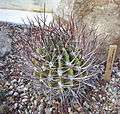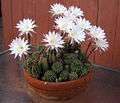Echinopsis
| Echinopsis | |
|---|---|
 | |
| Echinopsis spachiana | |
| Scientific classification | |
| Kingdom: | Plantae |
| (unranked): | Angiosperms |
| (unranked): | Eudicots |
| (unranked): | Core eudicots |
| Order: | Caryophyllales |
| Family: | Cactaceae |
| Subfamily: | Cactoideae |
| Tribe: | Trichocereeae |
| Genus: | Echinopsis Zucc. |
| Species | |
|
around 180, see text | |
Echinopsis is a large genus of cacti native to South America, sometimes known as hedgehog cactus, sea-urchin cactus or Easter lily cactus. One small species, E. chamaecereus, is known as the peanut cactus. The 128 species range from large and treelike types to small globose cacti. The name derives from echinos hedgehog or sea urchin, and opsis appearance, a reference to these plants' dense coverings of spines.
Echinopsis is distinguished from Echinocactus by the length of the flower tube, from Cereus by the form and size of their stems, and from both in the position on the stem occupied by the flowers. They are remarkable for the great size, length of tube, and beauty of their flowers, which, borne upon generally small and dumpy stems, appear much larger and more attractive than would be expected.
Distribution
Echinopsis species are native to South America (Argentina, Chile, Bolivia, Peru, Brazil, Ecuador, Paraguay and Uruguay). They grow only in situations where the soil is sandy or gravelly, or on the sides of hills in the crevices of rocks.
Cultivation
The growing and resting seasons for Echinopsis are the same as for Echinocactus. Research by J. Smith (former Curator at the Royal Botanic Gardens, Kew) showed that species like the Chilean Echinopsis cristata and its Mexican relatives thrive if potted in light loam, with a little leaf mould and a few nodules of limestone. The limestone keeps the soil open; it is important that the soil should be well drained. In winter, water must be given very sparingly, and the atmosphere should be dry; the temperature need not exceed 10 °C during the night, and in very cold weather it may be allowed to fall to 5 °C, provided a higher temperature of 14 °C is maintained during the day. In spring, the plants should receive the full influence of the increasing warmth of the sun; and during hot weather, they will be benefited by frequent spraying overhead, which should be done in the evening. The soil should never be saturated, as the soft fibrous roots will rot if kept wet for any length of time.
None of the species need to be grafted to grow freely and remain healthy, as the stems are all robust enough and of sufficient size to take care of themselves. The only danger is in keeping the plants too moist in winter, for although a little water now and again keeps the stems fresh and green, it deprives them of that rest which is essential to the development of their large, beautiful flowers in summer.

Taxonomy
Studies in the 1970s and 1980s resulted in several formerly separate genera being absorbed into Echinopsis:
- Acantholobivia Backeb.
- Acanthopetalus Y.Itô
- Andenea Fric (nom. inval.)
- Aureilobivia Fric (nom. inval.)
- Chamaecereus Britton & Rose
- Chamaelobivia Y.Itô (nom. inval.)
- Cinnabarinea Fric ex F.Ritter
- Echinolobivia Y.Itô (nom. inval.)
- Echinonyctanthus Lem.
- Furiolobivia Y.Itô (nom. inval.)
- Helianthocereus Backeb
- Heterolobivia Y.Itô (nom. inval.)
- Hymenorebulobivia Fric (nom. inval.)
- Hymenorebutia Fric ex Buining
- Leucostele Backeb.
- Lobirebutia Fric (nom. inval.)
- Lobivia Britton & Rose
- Lobiviopsis Fric (nom. inval.)
- Megalobivia Y.Itô (nom. inval.)
- Mesechinopsis Y.Itô
- Neolobivia Y.Itô
- Pilopsis Y.Itô (nom. inval.)
- Pseudolobivia (Backeb.) Backeb.
- Rebulobivia Fric (nom. inval.)
- Salpingolobivia Y.Itô
- Scoparebutia Fric & Kreuz. ex Buining
- Setiechinopsis (Backeb.) de Haas
- Soehrensia Backeb.
- Trichocereus (A.Berger) Riccob.
Some have proposed merging Rebutia as well.
Like several other taxonomic changes in Cactaceae, this one has not been universally accepted.[1] Amateur and professional growers still use names like Echinopsis (in the older sense), Lobivia, Setiechinopsis and Trichocereus, although many of the others listed above fell out of common usage long before the change.
Changing the genus name necessitated using some different specific epithets to avoid creating duplicate names. Thus both Echinopsis bridgesii and Trichocereus bridgesii previously existed. These are very different plants: Echinopsis bridgesii is a short clumping cactus, whereas Trichocereus bridgesii is a tall columnar cactus similar to E. (or T.) pachanoi. Under the new classification, Trichocereus bridgesii becomes Echinopsis lageniformis.
The genus name Trichocereus was given to a number of columnar cacti in 1909 by Vincenzo Riccobono, before the genus was subsumed—along with Lobivia—into Echinopsis in 1974 by Friedrich. A 2012 genetic and morphological study by Albesiano found Trichocereus to be monophyletic if it included three species of Harrisia.[2]
A 2012 genetic analysis of chloroplast DNA indicates Echinopsis is made up of several divergent lineages. E. spachiana was not included in the study but is thought to be related to a Helianthocereus clade.[3]
Species
- Note: some of the species listed below may be synonyms, subspecies, or varieties of others.
|
|
Many hybrids exist, mostly between similar species but also between more distinct ones, such as the cross between E. pachanoi and E. eyriesii which was sold under the name "Trichopsis pachaniesii" by Sacred Succulents.
Gallery
 Echinopsis cristata var. purpurea
Echinopsis cristata var. purpurea- Echinopsis eyriesii visited by a European honeybee; Kfar Blum Kibbutz garden, Israel.
 Echinopsis huascha Botanical Garden Meran
Echinopsis huascha Botanical Garden Meran Echinopsis chiloensis
Echinopsis chiloensis Echinopsis ferox c-3311
Echinopsis ferox c-3311 Echinopsis thelegona
Echinopsis thelegona Echinopsis backebergii
Echinopsis backebergii- Echinopsis bruchii
 Echinopsis oxygona
Echinopsis oxygona Echinopsis yuquina
Echinopsis yuquina
References
- ↑ Schick, Robert (2011), "Echinopsis sensu stricto and Trichocereus: Differentiating the Genera", Cactus and Succulent Journal, 83 (6): 248–255, doi:10.2985/0007-9367-83.6.248
- ↑ Albesiano, Sofía; Terrazas, Teresa (2012). "Cladistic Analysis of Trichocereus (Cactaceae: Cactoideae: Trichocereeae) Based on Morphological Data and Chloroplast Dna Sequences: Dedicated to Omar Emilio Ferrari (1936-2010)" (PDF). Haseltonia. 17: 3–23.
- ↑ Schlumpberger, Boris O.; Renner, Susanne S. (2012). "Molecular phylogenetics of Echinopsis (Cactaceae): Polyphyly at all levels and convergent evolution of pollination modes and growth forms" (PDF). American Journal of Botany. 99 (8): 1335–49. doi:10.3732/ajb.1100288.
Bibliography
- Edward F. Anderson, The Cactus Family (Timber Press, 2001) ISBN 0-88192-498-9, pp. 255–286
- K. Trout, Trout's Notes on San Pedro & related Trichocereus species (Sacred Cacti 3rd ed. Part B) (Moksha Press, 2005) ISBN 0-9770876-0-3
External links
| Wikimedia Commons has media related to Echinopsis. |
| Wikispecies has information related to: Echinopsis |
- Cactus Culture for Amateurs by W. Watson (1889)
- SucculentCity: Plant Profiles, Photographs & Cultivation Data
- Growing Trichocereus species (Plot55.com)
- IPNI
- Kuentz: Echinopsis (in French)
- Lohmueller: Echinopsis
- Mattslandscape; Echinopsis hybrids-growing culture
- Vimeo Video Echinopsis Cacti in Bloom
- echinopsis.com Photographs, Videos
- Echinopsis Cacti Flower Photographs, Videos